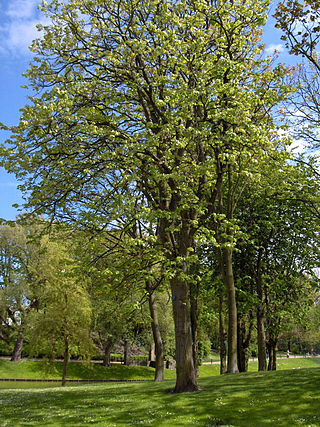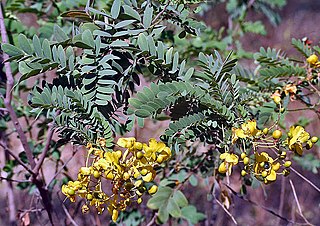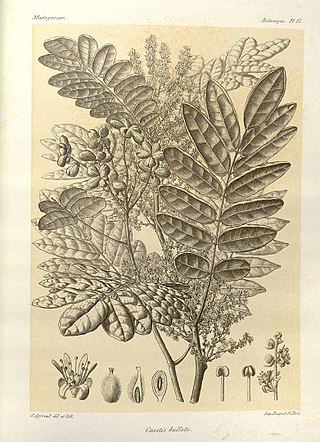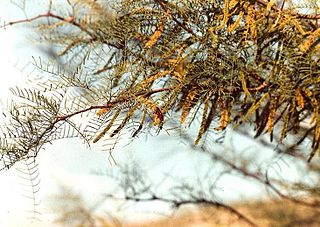
Tilia platyphyllos, the large-leaved lime or large-leaved linden, is a species of flowering plant in the family Malvaceae (Tiliaceae). It is a deciduous tree, native to much of Europe, including locally in southwestern Great Britain, growing on lime-rich soils. The common names largeleaf linden and large-leaved linden are in standard use throughout the English-speaking world except in the British Isles, where it is known as large-leaved lime. The name "lime", possibly a corruption of "line" originally from "lind", has been in use for centuries and also attaches to other species of Tilia. It is not, however, closely related to the lime fruit tree, a species of citrus.

Ziziphus mauritiana, also known as Indian jujube, Indian plum, Chinese date, Chinee apple, ber and dunks is a tropical fruit tree species belonging to the family Rhamnaceae. It is often confused with the closely related Chinese jujube, but whereas Z. jujuba prefers temperate climates, Z. mauritiana is tropical to subtropical.

Inga feuilleei, commonly known as pacay or ice-cream bean tree, is a tree in the family Fabaceae native to Andean valleys of northwestern South America. Pacay trees, as is the case with other trees in genus Inga, produce pods that contain an edible white pulp and have nitrogen-fixing roots.

Celtis occidentalis, commonly known as the common hackberry, is a large deciduous tree native to North America. It is also known as the nettletree, sugarberry, beaverwood, northern hackberry, and American hackberry. It is a moderately long-lived hardwood with a light-colored wood, yellowish gray to light brown with yellow streaks.

Senna auriculata is a leguminous tree in the subfamily Caesalpinioideae. It is commonly known by its local names matura tea tree, avaram or ranawara, or the English version avaram senna. It is the State flower of Indian state of Telangana. It occurs in the dry regions of India and Sri Lanka. It is common along the sea coast and the dry zone in Sri Lanka.
Philenoptera laxiflora, synonym Lonchocarpus laxiflorus, is a species of legume in the family Fabaceae. The tree grows to 4–8 meters in height, has grey or yellowish bark and compound leaves. New leaves are accompanied by purple flowers on multi-branched panicles. The fruit is a glabrous papery pod, usually containing one seed. Ph. laxiflorus is widely distributed in West Africa, Central Africa, the African Great Lakes, and Northeast Africa. It is found in savanna woodlands and dry forested areas, particularly fringing forest near water courses.
The American Elm cultivar Ulmus americana 'St. Croix' is a recent (2008) selection cloned from a large tree growing on a farm near Afton, Minnesota, which has displayed a high resistance to Dutch elm disease (DED). A U S patent, PP 20097, was granted in 2009.

Wrightia tinctoria, Pala indigo plant or dyer's oleander, is a flowering plant species in the genus Wrightia found in India, southeast Asia and Australia. It is found in dry and moist regions in its distribution. Various parts of the plant have been used in traditional medicine, but there is no scientific evidence it is effective or safe for treating any disease.

Millettia grandis is a species of plant in the family Fabaceae from South Africa. It is commonly called umzimbeet which is a name derived from the isiZulu name umSimbithwa.

Moringa stenopetala, commonly known as the African Moringa or cabbage tree, is a deciduous tree in the plant genus Moringa, native to Kenya and Ethiopia. A drought-resistant species, it is characterized by its bottle-shaped trunk, long twisted seed pods, and edible leaves likened to cabbage, from which its common name is derived. M. stenopetala is extirpated in the wild in Ethiopia, though still grown there as a crop on the terraces of the Ethiopian Highlands, mainly in the Konso region.

Ceriops tagal, commonly known as spurred mangrove or Indian mangrove, is a mangrove tree species in the family Rhizophoraceae. It is a protected tree in South Africa. The specific epithet tagal is a plant name from the Tagalog language.

Newtonia hildebrandtii, the Lebombo wattle, is a medium-sized tree native to eastern Africa. It is a protected tree in South Africa.

Cnestis polyphylla, or itch pod, is a liane or scrambling shrub belonging to the family Connaraceae and occurring south from Kenya in East Tropical Africa through Mozambique and Zimbabwe to Southern Africa where it is found in coastal and escarpment forest in Limpopo, Mpumalanga, Eswatini and KwaZulu-Natal, and further south to the Eastern Cape. It also grows on the Indian Ocean islands of Madagascar, Mauritius and Réunion. The genus has at least 13 species with many still unresolved. They are distributed mainly in tropical Africa and nearby islands, but extend to SE Asia and China.

Prosopis chilensis is a species of tree in the genus Prosopis, belonging to the family Fabaceae. It is found in parts of central Chile, southern Peru, Bolivia, and Andean (northwestern) Argentina. Its common names include Chilean mesquite, cupesí, and Chilean algarrobo. It is used for providing shade, for animal feed and for firewood.

Brachystegia eurycoma, a plant in the family Fabaceae, is a sizable species of tree found in southern Nigeria and western Cameroon. It has a spreading, flattened crown.
Daniellia oliveri is a species of tree in the family Fabaceae. It is native to tropical West and Central Africa and is commonly known as the African copaiba balsam tree, or the West African copal tree.

Gilbertiodendron dewevrei is a species of tree in the family Fabaceae, native to tropical rain forests in Central Africa. It is often the dominant tree species of the Guineo-Congolian rainforest. The timber is traded as limbali, and is used for construction, flooring and railway sleepers. It is also used for making boats, furniture, tool handles and joinery and for making charcoal.

Brachystegia laurentii, a plant in the family Fabaceae, is a species of large tree found in western Cameroon, Gabon, Equatorial Guinea, the Democratic Republic of the Congo and the Republic of the Congo. It has a dense, umbrella-shaped crown. The wood is known as bomanga and has many uses in building and construction.
Zanthoxylum laetum is a species of woody plant from the Rutaceae family.
Senegalia thomasii is a species within the family Fabaceae that grows as a straggling shrub or tree. It is commonly found in Kenya.

















